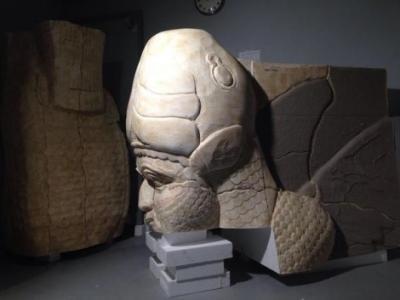3-D replicas revive victims of IS iconoclastic fury

ROME - Organisers of a project to reconstitute ancient works of art destroyed by Islamic State (IS) in Iraq and Syria hope their pioneering efforts will provide a model for international cooperation to preserve the world’s cultural heritage.
The recreated archaeological treasures went on display in the majestic setting of the Colosseum in October and will be on show in Italy’s most visited monument until Dec.11. The most striking of the three artefacts is a winged bull with a human head from Nimrud, in Iraq, which stands five metres tall. The original was reduced to dust last year by IS militants using bulldozers.
Part of the state archives hall from the ancient Syrian kingdom of Ebla and a section of the roof of the Temple of Bel in Palmyra have also been recreated for the exhibition using a variety of modern technologies.
Oxford University’s Institute for Digital Archaeology used similar 3-D printing techniques to create a two thirds scale replica of Palmyra’s Arch of Triumph, displayed in London and New York, but participants in the Italian project believe their technique is more advanced.
“Our technique was quite different from the English one,” said Frances Pinnock, co-director of an Italian expedition for the excavation of Ebla, which began in 1964. “We wanted to see if it is possible to reconstruct in real size. It’s not easy and takes a lot of time, scholarship, and money.”
Ms Pinnock said the Italians were keen to share their discoveries with the international scientific community. It was important that interested institutions stored and shared the basic information that made it possible to create accurate copies of ancient treasures.
Three Italian companies participated in the reconstruction project, using a variety of materials including polystyrene, latex, and plastic resins mixed with powdered stone. Arte Idea, a company that has frequently worked for the illusions of the cinema, used fibreglass to replicate the mud bricks of the Ebla archive.
The work was promoted by Francesco Rutelli, a former culture minister, and carried out under the supervision of UNESCO, the UN agency responsible for culture.
“There are many approaches to gathering the data: through satellites drones, laser scanners,” Mr Rutelli said. “Lots of people have been doing little pieces of the work, but no one has been coordinating the effort. We have to create a platform with a shared scientific database.”
Such information is important to preserve a record of archaeological treasures threatened not just by war, but by environmental disasters, such as earthquakes and floods. Accurate replicas could also relieve the pressures exerted on fragile ancient structures by mass tourism, members of the project said.
The Islamic State’s iconoclasm was intended to create terror in ordinary people and rally new militants to the extremists’ cause, Mr Rutelli said. “Beheading of people and symbols has happened throughout history. We Christians have our own history of iconoclasm. When I was mayor of Rome I worked in close proximity to the equestrian statue of Marcus Aurelius, a pagan emperor, which only survived because it was believed to represent Constantine, the first Christian emperor,” the former minister said.
The statue of the Roman leader remembered for his wise government has pride of place on the Capitoline Hill, near the mayor’s office. It is itself a replica, made in 1981, when the original was taken down for restoration and then kept indoors.
“The new iconoclasm is cynical and cinematic. It’s a Hollywood mise en scène, and cynical because behind the scenes IS is trafficking in small objects on the international black market to raise money.”
Mr Rutelli said the project also involved the restoration of two original funerary busts from Palmyra, attacked by the IS vandals and now placed on display in the Colosseum in their damaged state. The statues will be restored by Italian specialists and returned to Syrian government officials in Beirut, where the broken fragments had been transported by the Syrian antiquities department and then delivered into the care of the Italians.
The presence in the same exhibition of both damaged originals and completely artificial reconstructions illustrates the risk of confusion in the eye of the viewer, Ms Pinnock acknowledged, but she insisted there was no danger of Italian archaeologists contributing to a Disneyland of Mesopotamian treasures. “We have the capacity to create precise copies, which could be used for exhibitions in museums or to integrate damaged originals,” she said. “There are many possible solutions, but the restoration must be identifiable. That’s a basic principle of the Italian school of restoration.”
Ms Pinnock said it was moving to see objects from Palmyra, including the original funerary busts, on display in a symbol of ancient Rome, with which the desert city had cultural and trade relations.
The Colosseum had itself been exposed to neglect and depredations over its 2,000-year history, before being appreciated in modern times as a precious testament to a vanished civilisation.
“Some of the team were sceptical about the location,” Ms Pinnock said. “Now they are there, we see they are speaking with one another.”
pw


